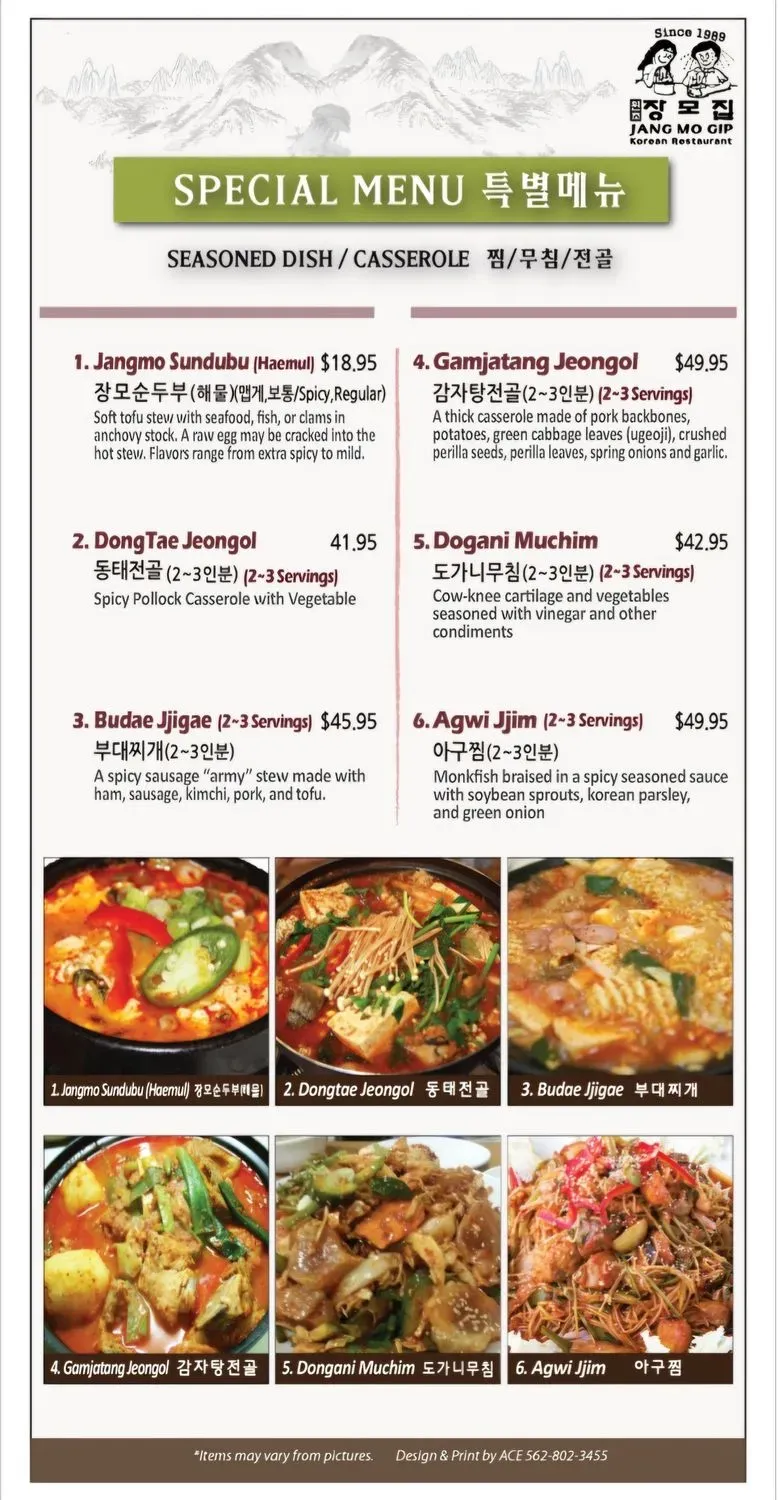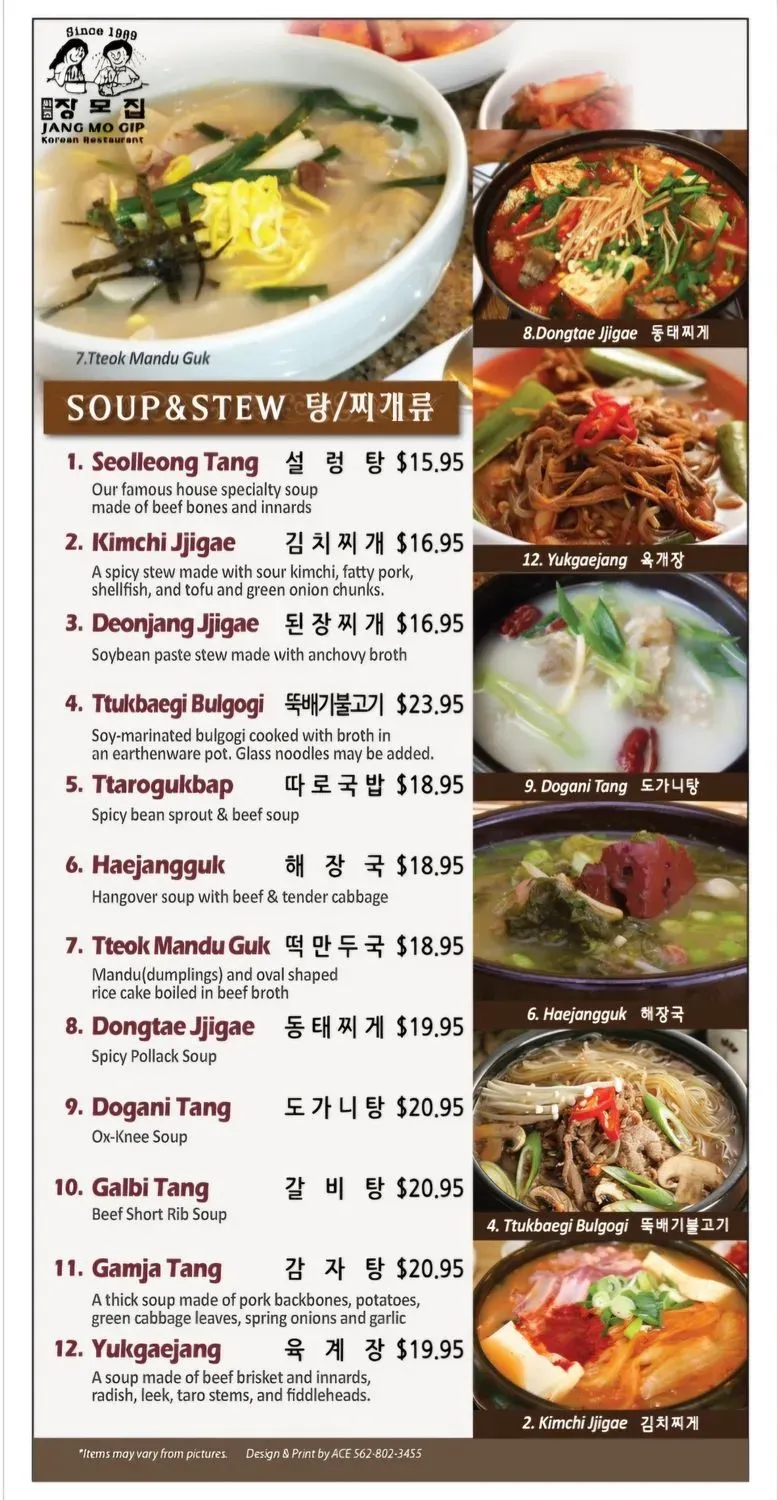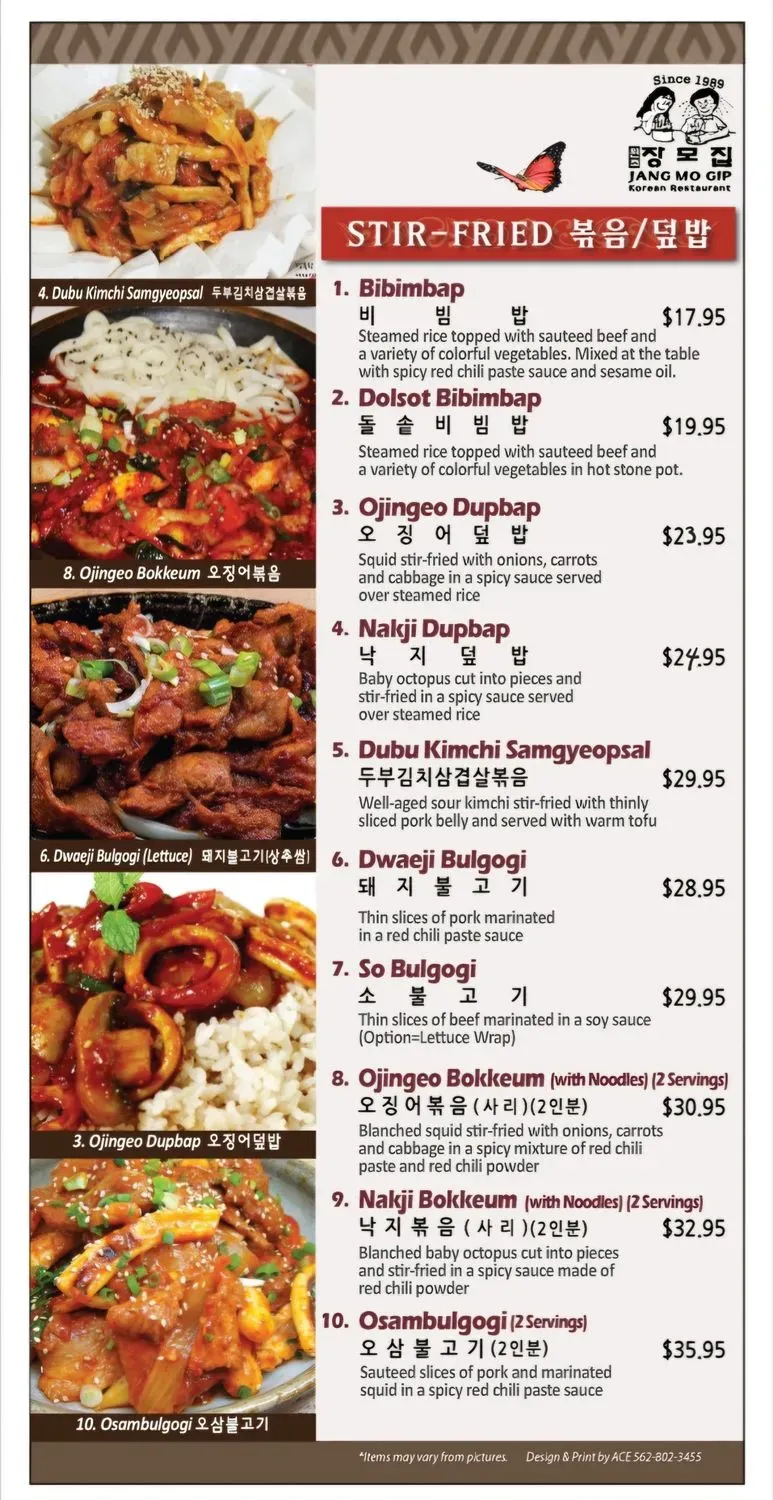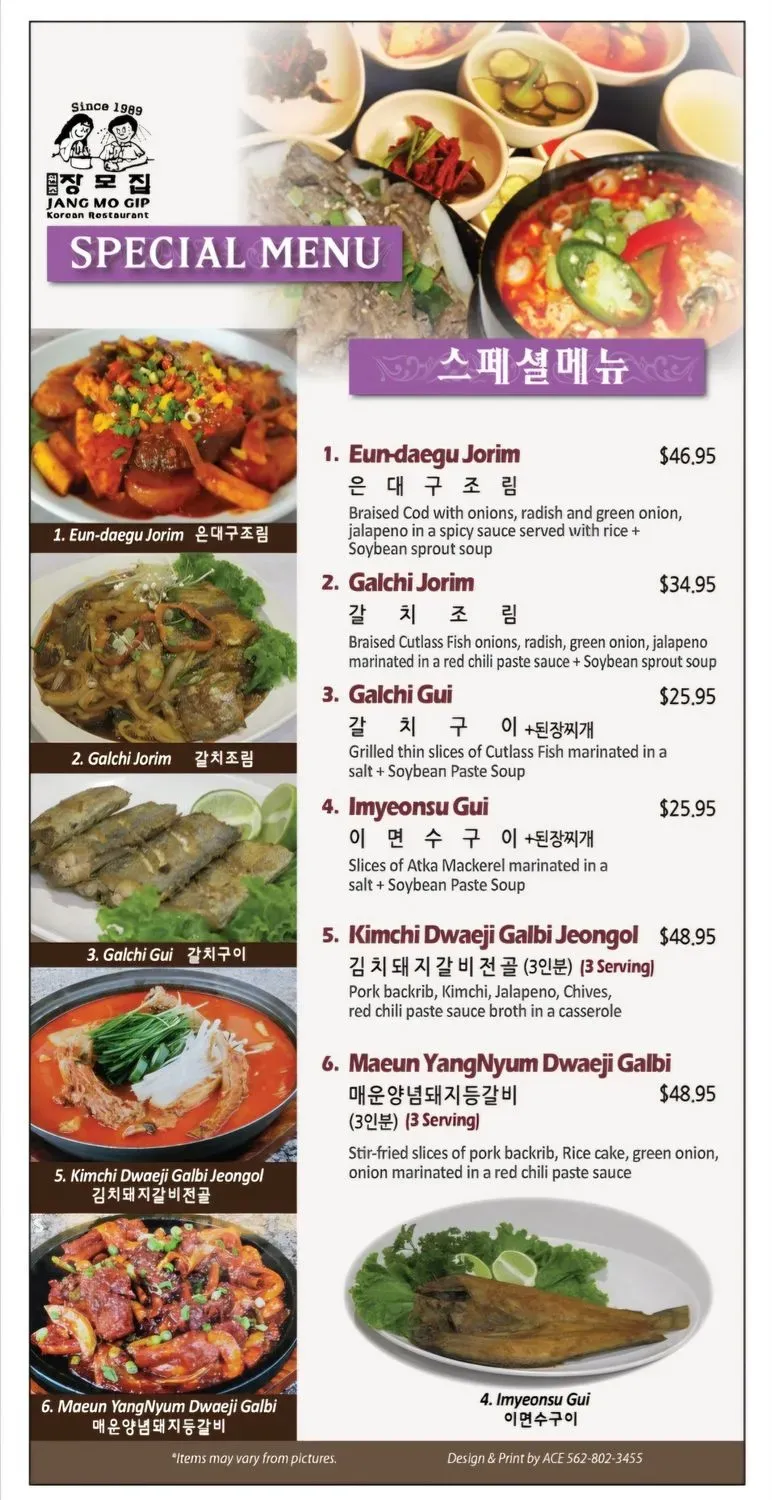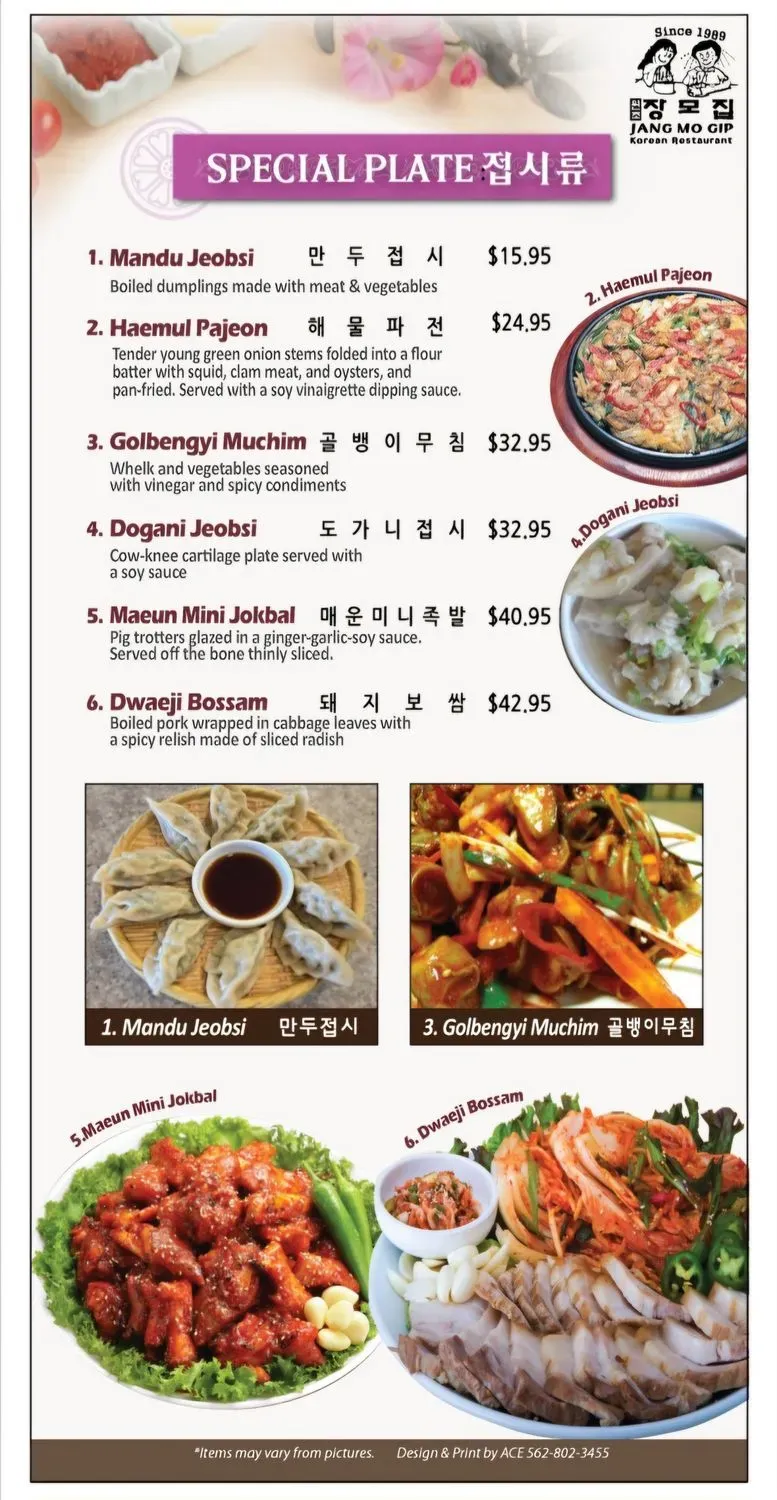Search
Popular Menus
- Beef Bulgogi[소불고기]Beef Bulgogi is one of Korea’s most beloved traditional dishes, featuring thinly sliced beef marinated in a sweet and savory sauce, then grilled or stir-fried to perfection. The name “bulgogi” comes from “bul” (fire) and “gogi” (meat), reflecting its method of cooking over an open flame. The beef is typically marinated in a mixture of soy sauce, sugar, sesame oil, garlic, and sometimes pear juice, which tenderizes the meat and infuses it with rich, complex flavors. The thin slices of beef cook quickly, and the dish is often prepared with vegetables like onions, carrots, and green onions, adding to the flavor and texture. Beef Bulgogi is usually served with rice or wrapped in lettuce or perilla leaves with ssamjang (a savory dipping sauce). This dish is a cornerstone of Korean barbecue and is loved worldwide for its tender texture and delightful balance of sweet and savory flavors.$32.95
- Bibimbap[비빔밥]Bibimbap is a signature Korean dish consisting of a bowl of warm rice topped with an assortment of vegetables, marinated meat (usually beef), a fried or raw egg, and gochujang (Korean red chili paste). The dish is mixed thoroughly before eating, combining all the flavors and textures into one harmonious bite. The vegetables typically include spinach, bean sprouts, mushrooms, and pickled radish, while the protein can vary from beef to tofu or chicken. One of the most popular versions is served in a hot stone pot (dolsot), which crisps the rice at the bottom, adding an extra layer of flavor and texture. Bibimbap is not only visually appealing with its vibrant colors but also highly nutritious, offering a balanced meal in terms of flavor and nutrients. This dish is beloved for its versatility and can be customized to suit different tastes and dietary preferences.$19.75
- Braised Beltfish[갈치조림]Braised Beltfish is a classic Korean dish featuring tender pieces of beltfish simmered in a rich, savory, and slightly spicy sauce. Known for its delicate texture and flavorful seasoning, this dish is a staple in Korean home cooking and is often enjoyed as a comforting main course. The beltfish is cooked in a sauce made from soy sauce, gochugaru (Korean red pepper flakes), garlic, ginger, sesame oil, and sugar, creating a perfect balance of savory, sweet, and mildly spicy flavors. Vegetables like radish, onions, green onions, and chili peppers are typically added, enhancing the dish with additional layers of texture and taste. As the fish cooks, it absorbs the flavorful sauce, resulting in a dish that is both tender and deeply seasoned. Braised Beltfish is often served with steamed rice, allowing diners to enjoy the rich sauce and soft fish together. This dish is beloved for its simplicity, satisfying flavors, and its ability to bring out the natural sweetness of fresh seafood.$38.45
- Braised Silver Cod[은대구 조림]Braised Silver Cod is a traditional Korean dish made by simmering tender silver cod in a rich, savory, and slightly spicy sauce. This dish is known for its delicate texture, flavorful broth, and bold seasoning, making it a popular choice among seafood lovers. The sauce is typically made with soy sauce, gochugaru (Korean red pepper flakes), garlic, ginger, sesame oil, and a hint of sugar to create a perfect balance of savory, spicy, and sweet flavors. Additional ingredients like radish, onions, green onions, and chili peppers are added to enhance the dish’s flavor and texture. As the cod simmers, it absorbs the flavorful sauce, resulting in a melt-in-your-mouth experience with every bite. Braised Silver Cod is often served as a main dish alongside steamed rice, allowing diners to enjoy the deeply seasoned sauce and tender fish together. This dish is not only a comforting meal but also a showcase of Korean cuisine’s ability to bring out the natural flavors of fresh seafood through harm$51.65
- Braised Spicy Monkfish[아구찜]Braised Spicy Monkfish is a popular Korean dish featuring tender monkfish simmered in a rich, spicy sauce along with an assortment of vegetables and seasonings. Known for its bold flavors and hearty texture, this dish is a favorite for those who enjoy Korean seafood with a spicy kick. The monkfish, prized for its firm yet delicate flesh, is braised in a sauce made from gochugaru (Korean red pepper flakes), gochujang (red chili paste), garlic, ginger, soy sauce, and sesame oil, creating a perfect balance of heat and savoriness. Vegetables such as bean sprouts, napa cabbage, onions, and green onions are added to provide crunch and freshness, while toppings like sesame seeds and chopped perilla leaves enhance the aroma and flavor. Braised Spicy Monkfish is often served as a communal dish, accompanied by steamed rice to balance the heat of the sauce. The combination of tender fish, flavorful sauce, and crisp vegetables makes Agujjim a standout dish in Korean cuisine, beloved for its sati$54.95
- Budae Jjigae[부대찌개]Budae Jjigae, also known as “Army Stew,” is a hearty and flavorful Korean hot pot dish that combines traditional Korean ingredients with Western-style additions. The dish originated after the Korean War, when processed meats like sausages and Spam were incorporated into Korean cuisine due to food scarcity. Over time, it evolved into a beloved comfort food. The stew typically features a spicy broth made with gochujang (Korean red chili paste), gochugaru (red pepper flakes), garlic, soy sauce, and anchovy stock. Ingredients such as sausage, Spam, tofu, kimchi, instant noodles, baked beans, and rice cakes are commonly included, along with fresh vegetables like onions, mushrooms, and green onions. A slice of cheese is sometimes added on top for extra richness. Budae Jjigae is served in a communal pot and cooked at the table, making it a perfect dish for sharing with family or friends. It is enjoyed with steamed rice and pairs well with Korean side dishes (banchan). Known for its bold fla$50.55
- Dongtae Jjigae[동태찌개]Dongtae Jjigae is a traditional Korean stew made with frozen pollock as the main ingredient. The use of frozen fish gives the broth a refreshing and clean taste. This hearty stew typically includes tofu, radish, green onions, chili peppers, and is seasoned with ingredients like red pepper powder, soybean paste, and minced garlic to enhance the flavor. The broth is spicy yet clear, making it a popular warm dish during the cold winter months. The combination of tender fish and spicy broth creates a comforting meal, often enjoyed with rice. Dongtae Jjigae has long been a beloved dish in Korean cuisine.$21.95
- Galbitang[갈비탕]Galbitang is a traditional Korean beef short rib soup. It’s made by simmering beef ribs for a long time, resulting in a rich, flavorful broth with tender pieces of meat. Common ingredients include brisket, garlic, green onions, and radish, which together create a savory and nutritious dish. The soup is typically served with rice, and the clear, mild flavor of the broth appeals to all ages. Galbitang is especially popular as a comforting meal during cold weather, warming both the body and soul. It’s enjoyed by savoring both the meat and the broth together.$23.05
- Gamjatang[감자탕]Gamjatang, or pork bone soup, is a popular traditional Korean dish made with pork backbone as the main ingredient. Despite its name, which includes “gamja” (meaning potato in Korean), the primary focus of the dish is the pork bones, not the potatoes. The name is believed to originate from an old term referring to the pig’s spine. The dish features a rich, spicy broth created by simmering pork bones for hours, flavored with gochujang (Korean chili paste), doenjang (soybean paste), red pepper powder, and garlic. Vegetables like napa cabbage, perilla leaves, and sometimes potatoes are added, bringing a satisfying balance of textures. Gamjatang is especially known as a hangover cure in Korea due to its hearty and spicy flavor, making it a popular choice for a comforting, warming meal.$23.05
- Grilled Beltfish[갈치구이]Grilled Beltfish is a popular Korean seafood dish that showcases the delicate flavor and tender texture of fresh beltfish. This dish is known for its simplicity and focus on highlighting the natural taste of the fish, making it a beloved choice in Korean cuisine. The beltfish is typically cleaned, lightly salted, and grilled to perfection over an open flame or pan. The grilling process gives the fish a crispy, golden-brown exterior while keeping the inside moist and flavorful. The natural richness of the fish shines through, enhanced by the light seasoning of salt. Grilled Beltfish is often served as a main dish, accompanied by steamed rice and a variety of Korean side dishes (banchan), such as kimchi, pickled radishes, or seasoned vegetables. This dish is prized for its clean, savory flavor and is a favorite among seafood lovers who appreciate simple yet delicious meals.$28.55
- Haemul Pajeon[해물파전]Haemul Pajeon, or seafood scallion pancake, is a popular Korean savory pancake made with a mixture of fresh seafood and green onions. The batter, made from wheat flour, is filled with various seafood like squid, mussels, and shrimp, along with long strips of green onions, and is pan-fried to crispy perfection. It is typically served with a dipping sauce made from soy sauce, vinegar, and chili flakes, adding a tangy and savory complement to the pancake. The contrast between the crispy exterior and the tender seafood inside makes Haemul Pajeon a flavorful and satisfying dish. This dish is particularly associated with rainy days in Korea, where it’s commonly enjoyed as a comforting meal or a snack with drinks. Haemul Pajeon is also a favorite dish in Korean bars, making it a go-to choice for both a hearty meal and a delightful appetizer.$27.45
- Hangover Soup[해장국]Haejangguk, or “hangover soup,” is a traditional Korean dish specifically eaten to cure a hangover after a night of drinking. The name “haejang” means “to relieve a hangover,” and this hearty soup lives up to its name. Typically made with ingredients like beef, ox blood, tripe, soybean sprouts, napa cabbage, and radish, it is simmered to create a rich and nourishing broth. There are many regional variations of haejangguk, such as bone hangover soup (Ppyeo Haejangguk) or blood sausage hangover soup (Sundae Haejangguk), each offering its own unique flavors. The spicy, savory broth is known to soothe the stomach and replenish nutrients, making it not only a popular hangover remedy but also a hearty and comforting meal in its own right.$20.85
- Kongguksu[콩국수]Kongguksu, or cold soy milk noodle soup, is a traditional Korean dish enjoyed during the hot summer months. It features wheat noodles served in a chilled, creamy broth made from ground soybeans, which gives it a rich, nutty flavor. The cold soybean broth is smooth and refreshing, providing a cooling effect perfect for warm weather. Toppings like thinly sliced cucumber, tomatoes, and sesame seeds are often added to enhance both flavor and texture. Kongguksu is mild yet nutritious, offering a good source of plant-based protein from the soybeans, making it a healthy and light meal. It’s typically seasoned to taste with salt or sugar, depending on personal preference.$17.55
- Kongnamul Guk[콩나물국]Kongnamul Guk, or soybean sprout soup, is a light and refreshing traditional Korean soup made primarily with soybean sprouts. The soup is simple yet flavorful, typically prepared by boiling the sprouts in water and seasoning with minced garlic, green onions, red pepper flakes, and salt. Some variations include beef or anchovy broth to add more depth of flavor, and for those who prefer a spicy kick, chili flakes or fresh chili peppers can be added. The crunchy texture of the soybean sprouts pairs perfectly with the clear, savory broth, creating a clean and comforting taste. Kongnamul Guk is known for its nutritional value and is especially popular as a hangover cure in Korea. It is a staple in Korean households due to its ease of preparation and health benefits.$15.35
- Korean Dumplings[만두접시]Korean Dumplings (called “Mandu”), a popular dish in Korea often enjoyed as a snack or appetizer. Mandu are made with thin wrappers filled with a variety of ingredients such as minced meat (usually pork or beef), vegetables like cabbage, green onions, and sometimes tofu. These dumplings can be steamed, pan-fried, or boiled, offering different textures depending on the preparation method. They are typically served with a dipping sauce made from soy sauce, vinegar, and sesame oil, adding a savory and tangy flavor to the dish. Mandu is a versatile dish that can be enjoyed on its own, as part of a soup (like Manduguk), or alongside other Korean main courses.$17.55
- Manduguk[만두국]Manduguk, or Korean dumpling soup, is a traditional dish made with dumplings (mandu) simmered in a light, savory broth. The dumplings are typically filled with a mixture of pork, beef, tofu, and vegetables, giving them a rich and hearty flavor. The broth is usually made from beef or bone stock, which complements the dumplings with a clear, mild taste. In some variations, spicy kimchi dumplings are used for a bolder flavor. Manduguk is often enjoyed during the Lunar New Year as a celebratory meal and is sometimes combined with rice cakes to create Tteok Manduguk. This comforting and nutritious soup is especially loved in the colder months, warming both the body and soul.$20.85
- Ojingeo Bokkeum[오징어볶음]Ojingeo Bokkeum is a popular Korean stir-fried dish featuring tender squid cooked in a spicy and savory sauce. The dish is made with thinly sliced squid, which is stir-fried with a flavorful mixture of gochujang (Korean red chili paste), gochugaru (red pepper flakes), soy sauce, garlic, and a touch of sugar for balance. The sauce gives the dish its signature bold and spicy flavor. To complement the squid, fresh vegetables like onions, carrots, green onions, and zucchini are often added, providing a variety of textures and a slight sweetness to the dish. Ojingeo Bokkeum is typically served with steamed rice to balance the heat and soak up the sauce, making it a perfect combination of spicy, savory, and satisfying flavors.$34.05
- Ojingeo Deopbap[오징어덮밥]Spicy Stir-fried Squid Rice Bowl, known as “Ojingeo Deopbap” in Korean, is a popular dish made with stir-fried squid in a spicy sauce, served over a bowl of rice. The squid is sliced and stir-fried in a flavorful mixture of gochujang (Korean chili paste), red pepper flakes, soy sauce, garlic, and sugar, delivering a perfect balance of spicy and sweet flavors. Vegetables like onions, carrots, and green onions are often added to enhance the taste and texture. The chewy squid combined with the bold, spicy sauce makes for a satisfying meal when paired with rice. This dish is particularly loved by those who enjoy spicy food and is a hearty, flavorful meal that’s both quick and easy to prepare.$26.35
- Osam Bulgogi[오삼불고기]Osam Bulgogi is a popular Korean stir-fried dish that combines squid (ojingeo) and pork belly (samgyeopsal) in a spicy and savory marinade. This flavorful dish is loved for its perfect harmony of tender squid and rich, fatty pork belly, creating a delightful contrast in texture and taste. The marinade is typically made with gochujang (Korean red chili paste), gochugaru (red pepper flakes), soy sauce, garlic, ginger, sesame oil, and a touch of sugar to balance the spiciness with a hint of sweetness. Fresh vegetables such as onions, green onions, carrots, and cabbage are stir-fried together with the squid and pork, adding crunch and balancing the flavors. Osam Bulgogi is often served with steamed rice to complement the spicy sauce and can also be wrapped in lettuce or perilla leaves for a fresh, Korean-style wrap. This dish is not only a great main course but also a popular choice as an anju (a dish paired with alcoholic beverages), especially with soju. Its bold, spicy flavors.$39.55
- Ox Knee Soup[도가니탕]Doganitang, or ox knee and tendon soup, is a traditional Korean soup made by simmering beef knee bones and tendons for an extended period to create a rich, milky broth. The broth is known for its mild yet deeply savory flavor, and the slow-cooked tendons give the soup a delightfully chewy texture. This dish is particularly prized for its high collagen content, believed to be beneficial for joint health and skin. Doganitang is typically seasoned with salt and pepper at the table, and garnished with chopped green onions and minced garlic. It’s often served with rice, making it a hearty and nutritious meal. Doganitang is especially popular as a health food in Korea, enjoyed as a comforting and warming dish, particularly during cold weather.$23.05
- Pork Bossam[돼지보쌈]Pork Bossam is a traditional Korean dish featuring tender, thinly sliced boiled pork belly served with a variety of flavorful accompaniments. The pork is carefully cooked with aromatic ingredients such as garlic, ginger, and sometimes doenjang (fermented soybean paste) to remove excess fat and enhance its flavor. Bossam is typically served with fresh or fermented napa cabbage leaves, which are used as wraps for the pork slices. It is accompanied by various side dishes, including kimchi, fresh garlic slices, green chilies, and ssamjang (a savory dipping sauce made from gochujang and doenjang). One of the highlights is kimchi bossam, where the pork is paired with a tangy and spicy radish kimchi (musaengchae), creating a perfect balance of textures and flavors. This dish is often enjoyed as a communal meal, where diners assemble their own wraps, combining pork, vegetables, and condiments according to their preferences. Pork Bossam is beloved for its rich flavor and versatility.$47.25
- Pork Bulgogi[돼지불고기]Pork Bulgogi is one of Korea’s most popular grilled meat dishes, featuring marinated pork cooked over high heat. Thinly sliced pork is seasoned with a savory and sweet marinade made from ingredients like gochujang (Korean red chili paste), soy sauce, sugar, garlic, sesame oil, and red pepper flakes, giving it a spicy and rich flavor. The meat is often stir-fried with vegetables such as onions, carrots, and green onions, adding more texture and depth to the dish. Pork Bulgogi is typically enjoyed with rice or wrapped in lettuce with ssamjang (a savory dipping sauce), making it a versatile and beloved Korean barbecue dish. Its spicy-sweet taste appeals to both Koreans and international diners alike, offering a quintessential taste of Korean barbecue cuisine.$31.85
- Seolleongtang[설렁탕]Seolleongtang is a traditional Korean ox bone soup made by simmering beef bones, brisket, and sometimes offal for several hours, resulting in a milky white broth. This hearty soup has a mild yet rich flavor, beloved by Koreans for its nourishing qualities. Seolleongtang is typically served with rice, and diners can season the broth with salt, pepper, and chopped green onions to suit their taste. The slow-cooked beef becomes tender, and the soup’s depth of flavor makes it a comforting dish, especially enjoyed during colder months or when one needs a revitalizing meal.$17.55
- Smoked Duck Salad[훈제오리무침]Smoked Duck Salad (Hoonje Ori Muchim) is a flavorful Korean dish made by tossing smoked duck with fresh vegetables and a tangy seasoning. The tender and smoky duck provides a rich, savory taste, while the vegetables, such as onions, chives, cucumbers, and lettuce, add a crisp texture and freshness. The salad is typically dressed with a sweet and spicy sauce made from gochujang (Korean chili paste), vinegar, sugar, and sesame oil, giving it a delicious balance of tangy, sweet, and savory flavors. Smoked Duck Salad is a popular dish that is often enjoyed as a light meal or a tasty accompaniment to drinks, offering a perfect combination of flavors and textures.$43.95
- Soy Sauce Marinated Crab[간장게장]Soy Sauce Marinated Crab is a traditional Korean dish made by marinating fresh raw crabs in a flavorful soy sauce-based brine. Often referred to as “the rice thief” because of its ability to make you eat endless amounts of rice, this dish is a beloved delicacy in Korean cuisine. To prepare Ganjang Gejang, fresh crabs are cleaned and soaked in a marinade made from soy sauce, garlic, ginger, sugar, and other aromatic ingredients. The crabs are left to marinate for several days, allowing the flavors to deeply penetrate the meat while preserving the crab’s natural sweetness. The result is tender, flavorful crab meat and rich, creamy roe that is best enjoyed over steamed rice. The dish is typically served cold as a side dish or main dish and is known for its umami-packed flavor and unique texture. Soy Sauce Marinated Crab is a true representation of Korean culinary mastery, showcasing the balance of salty, sweet, and savory flavors.$33.00
- Spicy Marinated Pork Ribs[매운양념 돼지갈비]Spicy Marinated Pork Ribs is a popular Korean barbecue dish where pork ribs are marinated in a spicy, flavorful sauce and grilled to perfection. The ribs are soaked in a marinade made from gochujang (Korean chili paste), red pepper flakes, soy sauce, garlic, sugar, and sesame oil, creating a perfect balance of sweet and spicy flavors. The pork ribs become tender and juicy as they are grilled, and the smoky char from the grill enhances the depth of the marinade. This dish is often served with lettuce or perilla leaves for wrapping, along with ssamjang (a savory dipping sauce), making it a fun, interactive meal. Spicy Marinated Pork Ribs is a favorite at Korean barbecue restaurants and gatherings, especially among those who enjoy bold, spicy flavors. It’s a must-try for anyone looking to experience the vibrant and hearty side of Korean cuisine.$64.85
- Spicy Mini Jokbal[매운미니족발]Spicy Mini Jokbal is a flavorful Korean dish featuring tender, bite-sized pieces of pork trotters cooked in a spicy, savory sauce. This dish offers the rich, gelatinous texture of traditional jokbal (pork trotters) combined with a bold, fiery kick, making it a favorite among spice lovers. The pork trotters are simmered until tender, then stir-fried or coated in a sauce made from gochujang (Korean red chili paste), gochugaru (red pepper flakes), garlic, soy sauce, sesame oil, and sugar for a perfect balance of heat and sweetness. The spicy sauce infuses the trotters with bold flavors, while optional toppings like sesame seeds and chopped green onions add texture and a hint of freshness. Spicy Mini Jokbal is often enjoyed with a side of steamed rice or wrapped in lettuce leaves for a refreshing contrast to the rich, spicy flavor. It’s also a popular choice as an anju (a dish served with alcoholic drinks), pairing especially well with soju or beer.$45.05
- Spicy Ox Knee Cartilage Salad[도가니무침]Spicy Ox Knee Cartilage Salad is a traditional Korean dish made by mixing tender pieces of ox knee cartilage with fresh vegetables and a flavorful, spicy sauce. This dish is prized for its unique chewy texture and its health benefits, as ox cartilage is rich in collagen, which is believed to promote joint and skin health. The cartilage is first boiled until tender, then sliced into bite-sized pieces and mixed with ingredients such as cucumbers, onions, carrots, and sometimes radish for added crunch. The dish is seasoned with a tangy and spicy sauce made from gochugaru (Korean red pepper flakes), vinegar, garlic, sesame oil, and a touch of sugar, creating a harmonious balance of heat, tanginess, and savory flavor. Spicy Ox Knee Cartilage Salad is often served as an appetizer or side dish, complementing other Korean meals with its refreshing and bold taste. It’s especially popular as a health-conscious dish and a unique offering in traditional Korean cuisine.$47.25
- Ttarogukbap[따로국밥]Ttarogukbap, or “separate soup and rice,” is a traditional Korean dish where the broth and rice are served separately. Unlike typical gukbap (rice soup), where the rice is mixed directly into the soup, Ttarogukbap allows diners to enjoy the distinct flavors of the broth and rice individually. The broth is usually made with beef or pork, simmered with ingredients like radish, green onions, and garlic, creating a rich and hearty flavor. Diners can choose to mix the rice into the soup or enjoy them separately, offering a customizable dining experience. Ttarogukbap is a warm, comforting meal, especially popular during colder weather for its hearty and nourishing qualities.$20.85
- Yukgaejang[육개장]Yukgaejang is a traditional Korean spicy beef soup known for its rich, deep flavors and hearty broth. This dish is made with shredded beef, typically brisket, which is simmered with red pepper flakes, soy sauce, garlic, green onions, bracken (fernbrake), bean sprouts, and other ingredients. The combination of tender beef and a variety of vegetables gives the soup a balanced mix of textures, while the spicy broth provides a warming, invigorating flavor. Yukgaejang is beloved for its bold spiciness and is often enjoyed as a comfort food, especially during cold weather or when someone needs a revitalizing meal. It’s typically served with steamed rice, making it a satisfying and nourishing dish.$21.95
![Beef Bulgogi[소불고기]](https://cdn.checkle.com/menuItems/-NANUzWH1M7FAsMkrzbU/e29cadcd-259d-48ea-9668-611eea1a8125_550x550)
![Bibimbap[비빔밥]](https://cdn.checkle.com/menuItems/-NANUzWH1M7FAsMkrzbU/d12b1357-ebfa-4a81-94ac-1eae9a004cb4_550x550)
![Braised Beltfish[갈치조림]](https://cdn.checkle.com/menuItems/-NANUzWH1M7FAsMkrzbU/39abaca5-6f63-4160-9747-4809ebf51410_550x550)
![Braised Silver Cod[은대구 조림]](https://cdn.checkle.com/menuItems/-NANUzWH1M7FAsMkrzbU/21242aae-7927-47f5-98a6-ed4dffce7735_550x550)
![Braised Spicy Monkfish[아구찜]](https://cdn.checkle.com/menuItems/-NANUzWH1M7FAsMkrzbU/98e1eec3-0400-4ece-b654-9d605193b736_550x550)
![Budae Jjigae[부대찌개]](https://cdn.checkle.com/menuItems/-NANUzWH1M7FAsMkrzbU/41b9d1af-6463-433e-881f-3aef671df0e9_550x550)
![Dongtae Jjigae[동태찌개]](https://cdn.checkle.com/menuItems/-NANUzWH1M7FAsMkrzbU/2a685204-c2ea-41aa-9911-27cfe779cfc3_550x550)
![Galbitang[갈비탕]](https://cdn.checkle.com/menuItems/-NANUzWH1M7FAsMkrzbU/8f66811d-8f91-4fb7-b6fc-ff03278e02c2_550x550)
![Gamjatang[감자탕]](https://cdn.checkle.com/menuItems/-NANUzWH1M7FAsMkrzbU/cc382a69-4499-49d9-8cf3-e5d6c66b64fa_550x550)
![Grilled Beltfish[갈치구이]](https://cdn.checkle.com/menuItems/-NANUzWH1M7FAsMkrzbU/49292eae-26e9-40c9-b080-6e09f5020666_550x550)
![Haemul Pajeon[해물파전]](https://cdn.checkle.com/menuItems/-NANUzWH1M7FAsMkrzbU/5283e2f2-f9d3-4818-8aee-9d41d28b8f15_550x550)
![Hangover Soup[해장국]](https://cdn.checkle.com/menuItems/-NANUzWH1M7FAsMkrzbU/2ad1a0a0-4a6d-46e3-9113-ef281b1c6d53_550x550)
![Kongguksu[콩국수]](https://cdn.checkle.com/menuItems/-NANUzWH1M7FAsMkrzbU/2f55ece3-4364-4dce-ae74-cff9f008cb6b_550x550)
![Kongnamul Guk[콩나물국]](https://cdn.checkle.com/menuItems/-NANUzWH1M7FAsMkrzbU/6fceea4f-7052-46c9-a9b5-c536fb0c8f30_550x550)
![Korean Dumplings[만두접시]](https://cdn.checkle.com/menuItems/-NANUzWH1M7FAsMkrzbU/f6947d2a-38e3-441a-be34-8ca51ccd1894_550x550)
![Manduguk[만두국]](https://cdn.checkle.com/menuItems/-NANUzWH1M7FAsMkrzbU/8f06bded-6ef3-4ee4-8b4d-8d0e7a76083b_550x550)
![Ojingeo Bokkeum[오징어볶음]](https://cdn.checkle.com/menuItems/-NANUzWH1M7FAsMkrzbU/595f919e-c883-4a17-81ac-e4df3ab485b1_550x550)
![Ojingeo Deopbap[오징어덮밥]](https://cdn.checkle.com/menuItems/-NANUzWH1M7FAsMkrzbU/8f5e7c31-63d8-4c9b-a100-dca478466c25_550x550)
![Osam Bulgogi[오삼불고기]](https://cdn.checkle.com/menuItems/-NANUzWH1M7FAsMkrzbU/e346aaf5-8a9f-4a21-b4aa-716c8ab760bf_550x550)
![Ox Knee Soup[도가니탕]](https://cdn.checkle.com/menuItems/-NANUzWH1M7FAsMkrzbU/57ebee87-8bcb-4e82-80b7-66d99a9e35e5_550x550)
![Pork Bossam[돼지보쌈]](https://cdn.checkle.com/menuItems/-NANUzWH1M7FAsMkrzbU/608e8b6c-3f31-4862-a48f-c3eeecdec13c_550x550)
![Pork Bulgogi[돼지불고기]](https://cdn.checkle.com/menuItems/-NANUzWH1M7FAsMkrzbU/810f88e5-b60b-485e-a22f-67aeab6817e1_550x550)
![Seolleongtang[설렁탕]](https://cdn.checkle.com/menuItems/-NANUzWH1M7FAsMkrzbU/8ccd31a7-8757-41ac-9003-6f81f23720f9_550x550)
![Smoked Duck Salad[훈제오리무침]](https://cdn.checkle.com/menuItems/-NANUzWH1M7FAsMkrzbU/1f7506ad-fe66-489f-8050-6be0e010632f_550x550)
![Soy Sauce Marinated Crab[간장게장]](https://cdn.checkle.com/menuItems/-NANUzWH1M7FAsMkrzbU/479e1fd5-2249-41e0-b72f-d867a16e67c4_550x550)
![Spicy Marinated Pork Ribs[매운양념 돼지갈비]](https://cdn.checkle.com/menuItems/-NANUzWH1M7FAsMkrzbU/9c83c073-ede4-4307-a006-24cb39a99337_550x550)
![Spicy Mini Jokbal[매운미니족발]](https://cdn.checkle.com/menuItems/-NANUzWH1M7FAsMkrzbU/d7dbe5c2-583d-44f5-a616-37b0fef139d4_550x550)
![Spicy Ox Knee Cartilage Salad[도가니무침]](https://cdn.checkle.com/menuItems/-NANUzWH1M7FAsMkrzbU/e4e9e8b3-6bb2-4654-ae44-38227caa4eb2_550x550)
![Ttarogukbap[따로국밥]](https://cdn.checkle.com/menuItems/-NANUzWH1M7FAsMkrzbU/89662d59-5120-4885-9800-127a712919e5_550x550)
![Yukgaejang[육개장]](https://cdn.checkle.com/menuItems/-NANUzWH1M7FAsMkrzbU/e8fd59d3-af3e-4c9e-bc83-8f664a6e34cf_550x550)
